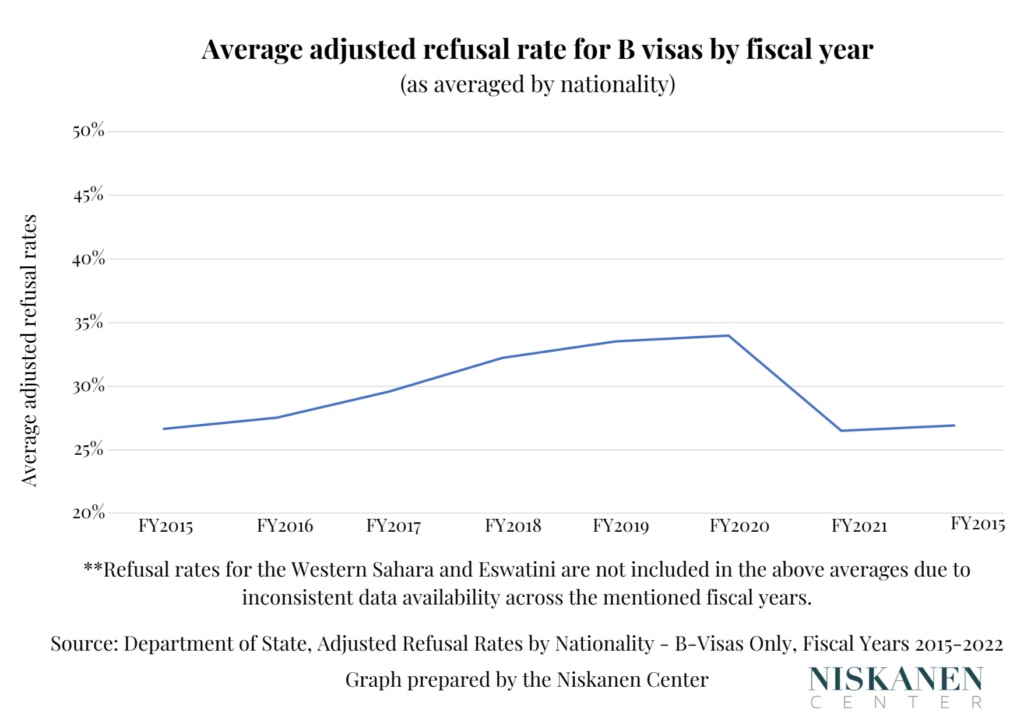Amid the pandemic, the Trump administration gave consular officers temporary authority to waive in-person interviews for certain nonimmigrant visa applicants, targeting those who had previously passed the interview and biometric screening process. This authority has been extended multiple times by the Biden administration and is now in effect until the end of 2023. In light of how extending these non-immigrant visa interview waivers helps America’s economy and the apparent improvements in the program’s efficiency, many stakeholders are already calling for the policy to be permanent.
However, limited outcome data is actually available in evaluating this policy’s efficacy. We know that the Department of State (DoS) adjudicated nearly half of all nonimmigrant visas issued in the last fiscal year without an in-person interview (amounting to nearly 3.5 million visas). As a proportion of all nonimmigrant visa applicants, an estimated 30 percent of applicants are thought to be eligible for the waiver, funneling the remaining 70 percent into the queue for in-person interview appointments.
The exceedingly long wait times for consular interviews have been a headlining issue for years: business visitors have postponed travel, and conferences have been relocated to accommodate visa setbacks. However, the extension of the interview waiver program seems to have played a significant role in improving those wait times.
Within the past several months, DoS saw a 22 percent decrease in average global wait time for interview-required student and exchange visitor applicants. Similarly, the wait times for interview-required temporary worker applicants dropped by 30 percent and for B-1/B-2 visitors requiring interviews by 11 percent.
With some consulates reporting visitor visa appointment wait times of over 700 days in November of 2022, a decrease to 157 days on average marks a stark decline. This drop can be attributed, in part, to the availability of interview waivers.
Wait times are only one metric for evaluating the effectiveness of non-immigrant visa interview waivers. We can also compare refusal rates to assess if in-person interviews correlate with a greater likelihood of visa refusal. As averaged across nationalities, B visa refusal rates have decreased since introducing interview waivers. However, the lower rates are generally consistent with the rates of refusal seen during the final years of the Obama administration (see the below graph).
When looking across all nonimmigrant visa categories, worldwide refusal rates have also decreased. Still, given the significant fluctuations in application quantities, the average change in refusal rates from one year to the next only amounted to about -0.1 percent from 2015 to 2022.

Overstay rates are another reliable measure of efficacy. One goal of the visa interview is to evaluate the long-term intentions of visa applicants, so virtual or waived interviews could have interfered with those evaluations. Indeed, the available data shows no indication that they did.
While the latest overstay data has yet to be released, we can look at H-2 eligible country lists as a function of those rates. To be eligible for participation in the H-2 visa program, a country must comply with the Department of Homeland Security and DoS’s standards regarding fraud, abuse, overstay rates, and other conditions. If a country’s nationals exhibit heightened levels of any of these factors, it will likely be removed from the list for the following year.
Comparing the list of countries designated in 2021 to the countries designated in 2023 (based on 2020 and 2022 overstay rates and fraud statistics respectively), we find that only Moldova was on the list in 2021 and not in 2023. This could indicate that Moldovan nationals may have had higher overstay rates in 2022 than in 2020.
In contrast, based on 2022 statistics, six countries ineligible in 2021 are now eligible, suggesting that these countries have experienced a decrease in overstay rates and other non-compliant behavior. With a six-to-one ratio of gains versus losses, it is likely that overall overstay rates declined based on the limited data currently available.
Taken together, these statistics suggest that extending the non-immigrant interview waiver program has, and will continue to, significantly benefited the U.S. by shortening wait times without costly changes to refusal or overstay rates.
The U.S. can take additional action to improve the accessibility of visa interviews and drive down wait times that hurt Americans and their businesses. The DoS could increase English-language interview offerings, capitalize on foreign service applicants by inviting them to join the Consular Affairs Bureau if they fall short of reaching the oral assessment, and create and improve mechanisms for accountability and staff sharing among U.S. consulates. Like the non-immigrant visa interview waiver, these practice improvements could better the immigration experience for American sponsors and immigrants alike without compromising the security or integrity of our laws.